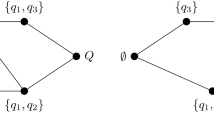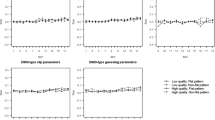Abstract
Conjunctive item response models are introduced such that (a) sufficient statistics for latent traits are not necessarily additive in item scores; (b) items are not necessarily locally independent; and (c) existing compensatory (additive) item response models including the binomial, Rasch, logistic, and general locally independent model are special cases. Simple estimates and hypothesis tests for conjunctive models are introduced and evaluated as well. Conjunctive models are also identified with cognitive models that assume the existence of several individually necessary component processes for a global ability. It is concluded that conjunctive models and methods may show promise for constructing improved tests and uncovering conjunctive cognitive structure. It is also concluded that conjunctive item response theory may help to clarify the relationships between local dependence, multidimensionality, and item response function form.
Similar content being viewed by others
References
Andersen, E. B. (1980).Discrete statistical models with social science applications. Amsterdam: North Holland.
Andersen, E. B. (1982). Latent trait models and ability parameter estimation.Applied Psychological Measurement, 6, 445–461.
Anderson, N. H. (1981).Foundations of information integration theory. New York: Academic Press.
Andrich, D. (1984, April). The attenuation paradox of traditionalist test theory as a breakdown of local independence in person item response theory. Paper presented at the National Conference of Measurement in Education, New Orleans.
Andrich, D. (1985). A latent-trait model for items with response dependencies: Implications for test construction and analysis. In S. E. Embretson (Ed.),Test design. Orlando, FL: Academic Press.
Birnbaum, A. (1968). Some latent trait models and their use in inferring an examinee's ability. In F. M. Lord & M. R. Novick (Eds.),Statistical theories of mental test scores. Reading, MA: Addison-Wesley.
Bussmeyer, J. R., & Jones, L. E. (1983). Analysis of multiplicative combination rules when the causal variables are measured with error.Psychological Bulletin, 93, 549–552.
Embretson (Whitely), S. (1984). A general latent trait model for response processes.Psychometrika, 49, 175–186.
Embretson, S. (1985, June). Component latent trait models: A remedy for local dependence? Paper presented at the 50th Annual Meeting of the Psychometric Society, Nashville.
Fischer, G. (1973). The linear logistic test model as an instrument in educational research.Acta Psychologica, 37, 359–374.
Fischer, G. (1981). On the existence and uniqueness of maximum-likelihood estimates in the Rasch model.Psychometrika, 46, 59–77.
Fischer, G., & Formann, A. K. (1982). Some applications of logistic latent trait models with linear constraints on the parameters.Applied Psychological Measurement, 6, 397–416.
Gaier, E. L., & Lee, M. C. (1953). Pattern analysis. The configural approach to predictive measurement.Psychological Bulletin, 50, 140–148.
Goldstein, H. (1980). Dimensionality, bias, independence and measurement scale problems in latent trait test score models.British Journal of Mathematical and Statistical Psychology, 33, 234–246.
Hambleton, R. K., Swaminathan, H., Cook, L. L., Eignor, D. E., & Gifford, J. A. (1978). Developments in latent trait theory: Models, technical issues, and applications.Review of Educational Research, 48, 467–510.
Harper, D. (1972). Local dependence latent structure models.Psychomerika, 37, 53–57.
Holland, P. W. (1981). When are item response models consistent with observed data?Psychometrika, 46, 79–92.
Horst, P. (1954). Pattern analysis and configural scoring.Journal of Clinical Psychology, 10, 3–11.
Huynh, H. (1977). Two simple cases of mastery scores based on the beta-binomial mode.Psychometrika, 42, 601–608.
Jannarone, R. J., & Roberts, J. S. (1984). Reflecting item interactions in scale construction: Meehl's paradox revisited.Journal of Personality and Social Psychology, 47, 631–637.
Kelderman, H. (1984). Loglinear Rasch model tests.Psychometrika, 49, 223–245.
Kempf, W. F. (1977). A dynamic test model and its use in the microevaluation of instructional material. In H. Spada & W. F. Kempf (Eds.),Structural models of thinking and learning. Vienna: Hans Huber.
Koch, G. G., & Landis, J. R. (1977). A general methodology for the analysis of experiments with repeated measurements of categorical data,Biometrics, 33, 133–158.
Lord, F. M., & Novick, M. R. (1968).Statistical theories of mental test scores. Reading, MA: Addison-Wesley.
McDonald, R. P. (1967). Nonlinear factor analysis.Psychometric Monograph, Number 15, 32(4, Pt 2).
McKinley, R. L., & Reckase, M. D. (1983).An extension of the two-parameter logistic model to the multidimensional latent space (Research Report Number R83-2). Iowa City: American College Testing Program.
Megargee, E. I. (1972).The California Psychological Inventory Handbook. London: Josey-Bass.
Molenaar, I. W. (1983). Some improved diagnostics for failure of the Rasch model.Psychometrika, 48, 49–72.
Rao, C. R. (1965).Linear statistical inference and its applications (2nd ed.). New York: Wiley.
Rasch, G. (1980).Probabilistic models for some intelligence and attainment tests. Chicago: University of Chicago Press.
Rosenbaum, P. R. (1984). Testing the conditional independence and monoticity assumptions of item response theory.Psychometrika, 49, 425–436.
Stegelmann, W. (1983). Extending the Rasch model to a general model having more than one dimension.Psychometrika, 48, 259–268.
Sternberg, R. S. (1977).Intelligence, information processing and analogical reasoning. Hillsdale, NJ: Erlbaum.
Sympson, J. B. (1977, July).A model for testing with multidimensional items. Paper presented at the University of Minnesota, Computerized Adaptive Testing Conference, Minneapolis.
Wainwright, G. (1965).Configural information in item responses. Unpublished doctoral dissertation, University of Washington.
Whitely, S. E. (1980). Multi-component latent trait models for ability tests.Psychometrika, 45, 479–494.
Yellot, J. I., Jr. (1977). The relationship between Luce's choice axiom, Thurstone's theory of comparative judgement and the double exponential distribution.Journal of Mathematical Psychology, 15, 109–144.
Yen, W. M. (1981). Using simulation results to test a latent trait model.Applied Psychological Measurement, 5, 245–262.
Author information
Authors and Affiliations
Additional information
I appreciate the many helpful suggestions that were given by the reviewers and Ivo Molenaar.
Rights and permissions
About this article
Cite this article
Jannarone, R.J. Conjunctive item response theory kernels. Psychometrika 51, 357–373 (1986). https://doi.org/10.1007/BF02294060
Received:
Revised:
Issue Date:
DOI: https://doi.org/10.1007/BF02294060




